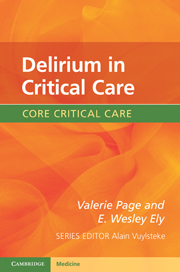Book contents
- Frontmatter
- Contents
- Foreword
- Delirium, a patient testimony
- 1 What is delirium in critical care?
- 2 How common is delirium in critical care?
- 3 What does delirium look like in critical care?
- 4 Delirium in critical care: how does it happen?
- 5 Delirium: what causes it? Risk factors
- 6 Delirium in critical care: why is it important?
- 7 Delirium in critical care: how do we diagnose it?
- 8 How to prevent delirium?
- 9 Treatment of delirium in critical care
- 10 Mental capacity and restraints
- 11 End-of-life care
- 12 What is the future?
- Selected references
- Index
- References
8 - How to prevent delirium?
Published online by Cambridge University Press: 05 December 2011
- Frontmatter
- Contents
- Foreword
- Delirium, a patient testimony
- 1 What is delirium in critical care?
- 2 How common is delirium in critical care?
- 3 What does delirium look like in critical care?
- 4 Delirium in critical care: how does it happen?
- 5 Delirium: what causes it? Risk factors
- 6 Delirium in critical care: why is it important?
- 7 Delirium in critical care: how do we diagnose it?
- 8 How to prevent delirium?
- 9 Treatment of delirium in critical care
- 10 Mental capacity and restraints
- 11 End-of-life care
- 12 What is the future?
- Selected references
- Index
- References
Summary
Introduction
It is estimated that we can prevent 30% of delirium in a general hospital. In critical care we are often dealing with and treating consequences of illnesses or their complications. When it comes to delirium, however, we need to focus on prevention as the core strategy. The expression ‘prevention is better than cure’ being very much the case. Current prevention tactics are based on the risk factors outlined in Chapter 5.
Successfully preventing delirium
The few studies that have looked at the prevention of delirium have included elderly patients admitted following a fractured neck of femur, or other general medical conditions. These studies provide a disparate group of interventions. The landmark study done by Inouye et al. was published in the New England Journal of Medicine in 1999. In an elderly population (the average age was 80 ± 6 years), they attempted to address some of the problems from previous studies such as small samples, use of non-targeted interventions and relatively insensitive outcome measures. Moreover, they set out to compare matched patients, with one receiving the interventions and one the usual care.
When allocated to the intervention group, the patient was entered into ‘The Elder Life Program’. This addressed six factors thought to be modifiable in clinical practice, using a predefined protocol for each (Table 8.1).
- Type
- Chapter
- Information
- Delirium in Critical Care , pp. 139 - 152Publisher: Cambridge University PressPrint publication year: 2011

